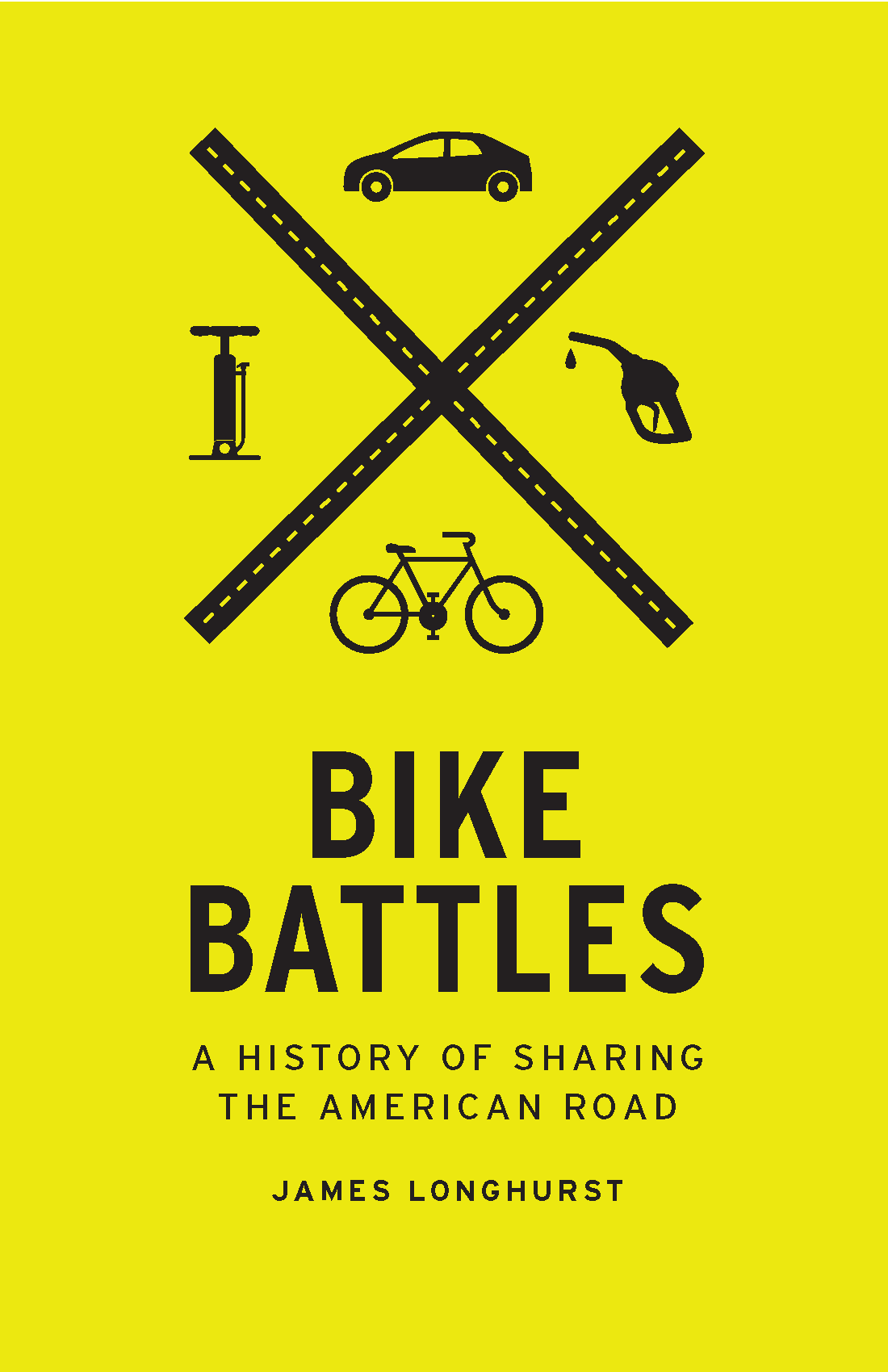As cyclists struggle to recover their space in the roads, conflicts involving bicycles are attracting more and more attention. Thinking of the road as a commons, as proposed by environmental historian James Longhurst in his new book Bike Battles: A History of Sharing the American Road, may give an entry point to a political ecology perspective.

Bike Battles, 2015, published by University of Washington Press.
James Longhurst, the author of Bike Battles: A History of Sharing the American Road (University of Washington Press, 2015), is an associate professor of History at the University of Wisconsin – La Crosse. He specialises in urban environmental history and public policy and is also author of the book Citizen Environmentalists (Tufts University Press, 2010). We recently asked him about his new book, his research and the relevance of a historical perspective for the analysis of present day conflicts involving the bicycle.

James Longhurst, author of Bike Battles.
One could say that Bike Battles is not really about bikes nor about battles, but about managing the commons and about urban politics. Do you agree? Could you tell us more about the idea of the road as a commons?
This idea — that it is illuminating to think of the road as a commons — is a symptom of my biases and interests; I’m a historian of urban and environmental policy, and of course I think of the road in the terms of those fields. Other scholars would likely approach the road as an object, or a technology, or an institution, or a center of social interaction. I think of it as a managed and exhaustible resource, and tend to apply the ideas that scholars I read have already come up with to understand pollution and resource extraction and forest management.
Of course I was predisposed to adapt Elinor Ostrom’s ideas of the common-pool resource, or Derek Wall on the new commons, since they were the tools I had at hand. And making the intellectual connection to Garret Hardin’s “Tragedy of the Commons” also serves to pull in readers of environmental philosophy and history who might not otherwise consider history of the road, or of the bicycle, as worthy subjects. I love to have conversations with other scholars who have different tools to apply to cycling, and see what they come up with.
Positing the road as a commons is a step towards a rational explanation of the (otherwise entirely) irrational rage experienced in disputes over that shared resource. Sharing is hard. Both on the road and in the halls of power, disputes over shared resources quickly get out of hand. Understanding the road as a disputed, limited resource allows for a fuller understanding of the anger and occasional violence that takes place between disparate user groups. These conflicts are not unique to the US, and not unique to car culture; they are to be expected in any abrupt transition between allocation regimes. Where there is no institution or cultural pattern that manages a commons, small changes in allocation can feel destabilizing or threatening to user groups, to the point of overreaction. But historical perspective can demonstrate that these transitions are inevitable, and are in fact a part of any common-pool resource.
As many people have noticed, the title Bike Battles might be a bit misleading. I’m not a fan of the cars-vs-bikes rhetoric, so it’s not a title advocating a battle of bikes on cars; nor is it a title reflecting a choice between the sides. It’s a title that implies that conflicts over user groups in the commons are cyclical and omnipresent because that is the way that shared resource allocation is always negotiated. I really wanted to subtitle the book “selected and periodic public policy debates about the bicycle” but my editor was not pleased with that idea at all and so Bike Battles — plural — it is.
I really enjoyed chapter 4, focused on the period of the Second World War. Could you briefly tell us about your research on the Victory Bicycle program to promote cycling by adults and what do you think is the relevance of this period today?
In researching Bike Battles I came across a number of topics where historians hadn’t really done much research; some of these made it into the book and some I’m still working on. There were several new areas, including the sidepath movement of the 1890s [advocating for protected bike lanes] and the importance of American military decision-making in rebuilding the Japanese bicycle industry after WWII.
Another was the internal records of the Victory Bike initiative on the American homefront during WWII, which were just sitting in the [United States] National Archives, untouched. I spent months and even years looking through secondary publications after I found these primary sources, because I just couldn’t believe that no one had written about them before.
But it turned out to be true that while scholars had written about the existence of — and journalistic coverage of — the Victory Bike program, they hadn’t really explored the internal records of the federal agencies that had debated and administered the program. And it turned out that there was a real rhetoric/reality disconnect with the Victory Bike. What was reported at the outset of the war was more aspirational and inspirational than what really happened.

One of widely publicised pictures of the Victory Bike initiative. Leon Henderson, director of the US Office of Price Administration, rides a World War II Victory bicycle with his secretary, Betty Barrett, on the basket. Washingon DC National Mall (1942). Source: Longhurst, J. (2015), Bike Battles, University of Washington Press.
Federal agencies began the war with some assumptions about eliminating almost all consumer sales of new cars; rationing parts, fuel, and tires for existing personal automobiles; encouraging bicycle by adults; and encouraging public transit while minimizing resource demands for consumables. So bicycle usage by adults was re-cast as patriotic sacrifice in wartime. But promised production of bicycles was quickly strangled under a strict rationing scheme — federal agencies disagreed vehemently about what would be the most efficient use of strategic resources, with some arguing strongly for almost no investment in transportation under a kind of worst-case-scenario austerity plan. Eventually the Victory Bike initiative unintentionally turned into a limited, strict rationing program that associated bicycling with deprivation and scarcity in the minds of many Americans, and all but eliminated American bicycle manufacturing firms. It had a lasting and debilitating impact on American adult bicycling, which is more or less the opposite of what one might assume based on the journalistic propaganda at the beginning of American involvement in the war.
One of the reasons that bicycles persist, even when writers aren’t paying attention to them, is that bicycles as useful objects have a long lifecycle.
What do all the battles presented in the book have in common?
Besides the importance of cultural association to decision-making, one easily-overlooked commonality between these moments is that the bicycle never actually goes away. It’s persuasive to periodize American bicycle history into three or four big booms, but I think the language of boom and bust is deceptive. What we’re really talking about is a change in attention to cycling, not in an absolute sense that all bicycles and bicyclists actually appear or disappear. After the 1890s Golden Age of cycling, after World War II and after the 1970s oil crisis, bicycling continued. If you look at sales figures, they don’t entirely match up to a sort of “three boom” story line; certainly, there are swings, but the bicycle doesn’t disappear for all user groups.
One of the reasons that bicycles persist, even when writers aren’t paying attention to them, is that bicycles as useful objects have a long lifecycle. As a hobby, I rehabilitate 1960s Schwinn bikes. I’ve picked up bikes from garages with original tires on them, and with a little bit of work they can take to the road quite easily. So while the past booms are mostly measured in increases in sales of new bikes and parts, that might not capture the fact that no new sale needs to take place in order for someone to ride. Just because journalists aren’t writing about it doesn’t mean it’s not happening. Our attention is diverted, but it continues in the time between booms. Bicycling never really goes away.

Bicycle advertisement, 1919. Source: Longhurst, J. (2015), Bike Battles, University of Washington Press
A lot of the research presented in Bike Battles has been done in the archives, but you also use other original sources, such as educational films and advertisements. Bikes may have never left completely the roads, but it could seem so looking into the archives for certain time periods. How did you find them between the 1950s and 1970s?
When I started this project, I wanted to study these moments of policy decision, but I was faced with two problems: first, policy history can be incredibly dry and boring, and second, since Americans don’t entirely take bicycles seriously, they haven’t always written or kept records about them. It’s really quite frustrating, when you come to the periods of the 1930s and the 1950s — you know that there are important decisions being made about the bicycle at federal and state levels, but there are so very few records. I solved these problems by finding that there were significant collections of untapped primary sources about select moments (including sidepaths of the 1890s and the WWII victory bike), but also by including popular culture in film, television, song, comic books, Boy Scout merit Badge pamphlets, and “Leave it to Beaver” episodes in the decades where few other sources were available.

Cover of “Sprocketman”, bicycle safety comic, reprinted by federal Consumer Products Safety Commission, 1970s. Source: Longhurst, J. (2015), Bike Battles, University of Washington Press
The intent here was to trace the cultural associations that explain why policymakers treat the bicycle the way they do, but I also got to have a lot of fun discovering pop culture and “reading in” the policy implications. I think that this was a useful perspective — for example, being forced to read the Boy Scout magazines and merit badge pamphlets was useful in understanding the throughout most of the 20th century, the Boy Scouts of America was the largest nationwide bicycle advocacy and educational group in existence; a sign of a diminished adult bicycling culture in comparison to other nations.
I have curated some of my favorite bicycle films on Youtube. One early example is A Trip Down Market Street Before the Fire (1906), an amazing document that captures the contested, shared space of the urban street in San Francisco before the thing that we call “traffic control”. In the early 1950s, Drive Your Bike (1954) is a typical example of post-war bicycle education. This film was made by an independent distributor on a shoestring budget, and targeted children partially by arguing that good cycling now would lead to good driving later, when as adults they would be expected to leave the childish bike behind. But this document also shows how bicycle advocacy throughout the 20th century promoted a viewpoint that placed the bicycle in the streets as traffic, long before the philosophy later known as “vehicular cycling“.
Finally, Only One Road: The Bike/Car Traffic Mix (AAA, 1975) is an amazing document, produced by the AAA Foundation for Traffic Safety. In response to the 1970s bike boom, the AAA is here scrambling to come up with an approach to the increase in adult cyclists. This is an honest attempt to grapple with multiple user groups, and this largely-forgotten film deserves more thoughtful analysis.
[youtube https://www.youtube.com/watch?v=Fy_uXSemm0I&w=420&h=315]
Concerning the ongoing battles about the bicycle and road sharing, some have related bike lanes to environmental gentrification. What is your opinion about it?
I think of this at least partially as one of those moments where cultural associations of the bicycle and its users influence policy debate. In the past, the bicycle has been associated with many different user groups and meanings; for example, in the late 1890s, it was associated with modernity and white, male, urban elites. This meant that turn-of-the-century attempts to define bicycle-specific infrastructure as a public good were rhetorically difficult. But the bicycle has been variously associated with bloomer-clad New Women, children, lawless telegraph messengers, patriotic war workers, health and fitness evangelists, and environmentalists. Some of these associations linger, even if they don’t accurately reflect the actual demographics of bicycle user groups.
So when activists or urban planners propose bike lanes today, one common association is with an upwardly mobile, affluent, white male contingent of “cyclists” on several-thousand-dollar machines. Even if we know that a very large percentage of urban bicycle users is made up of other groups — recent immigrants, those who are working low-wage service jobs, families who are unable to afford the expense of a car, or people who live in neighbourhoods with poor service from public transit or transportation networks — bike lanes are not associated with them. Instead, we link demands for bike lanes with outspoken yuppies or millennial hipsters transforming urban neighbourhoods to their liking — exactly the image of gentrification.
I think that these affiliations and cultural associations are very important to understand policy debates and impasses like gentrification. We know from the research of historians like Ruth Oldenziel that early 20th-century cyclists in many European nation are associated with working class politics. But that doesn’t seem to be the case in the United States –we don’t have a readily-accessible tradition of working class bicyclists, or of bicycle infrastructure being seen as a political project of the urban poor and working class. It’s counter-intuitive, if you think of it; bicycling, the cheapest transportation tool (besides walking), is associated in the US with affluence and privilege.
I hope that in a small way, re-examining the history of the bicycle, and re-forging these forgotten associations with many different uses and user groups, can serve to defuse these types of debates. The bicycle has been appropriated by many different groups, for many different purposes and goals, over time. Knowing that might mean accepting the way that bicycles are already used in a neighbourhood or community, and serving those needs without imposing new patterns; or accepting new infrastructure with the understanding that it will soon become part of the fabric of the existing community just from its presence over time.





